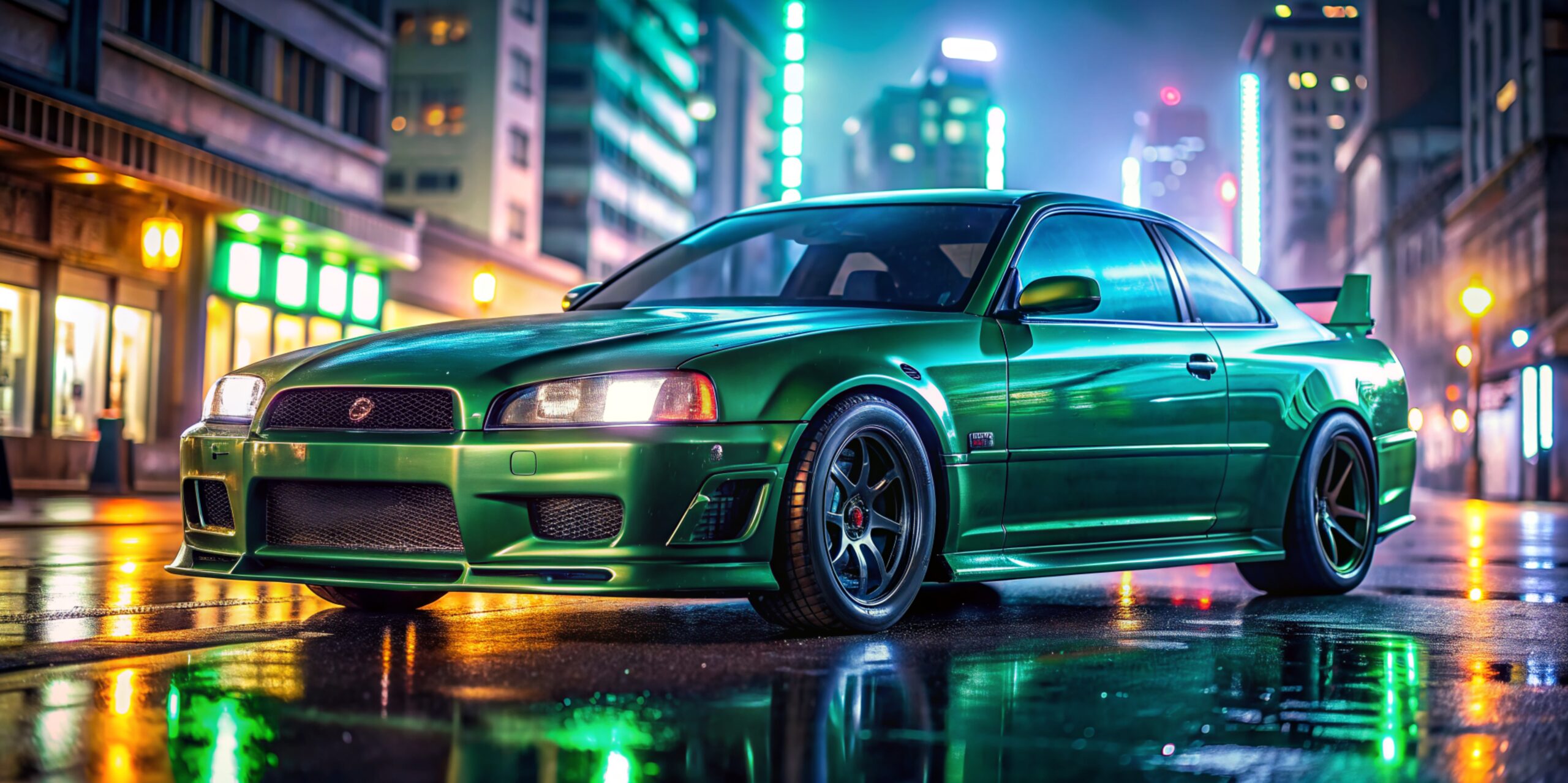The allure of Japanese Domestic Market (JDM) cars has captivated automotive enthusiasts for decades. Known for their unique designs, innovative engineering, and spirited performance, these vehicles have transcended their origins to become global icons. As we journey through the landscape of JDM cars today, we explore their cultural impact, the passion they inspire, and the challenges faced by enthusiasts in a rapidly evolving market.
The Rise of JDM Cars: A Cultural Phenomenon
The rise of JDM cars can be traced back to the late 20th century when Japanese automakers began to gain prominence in the global automotive market. This period marked a shift in consumer preferences, as performance-oriented vehicles with distinct aesthetics started to emerge. Models such as the Toyota Supra and Nissan Skyline GT-R became symbols of a burgeoning car culture that appealed to younger audiences seeking individuality and excitement.
JDM cars gained widespread recognition through various media, notably in video games and films. The "Fast & Furious" franchise, which debuted in 2001, showcased a range of JDM vehicles, embedding them into popular culture. This exposure fueled interest among car enthusiasts and casual fans alike, creating a vibrant community that shared a common passion for automotive excellence.
The internet played a pivotal role in the rise of JDM culture, allowing enthusiasts to connect, share knowledge, and showcase their vehicles. Online forums, social media, and dedicated websites became platforms for discussions about builds, modifications, and events. This surge in connectivity helped solidify JDM cars as a cultural phenomenon, transcending geographical boundaries.
As nostalgia for the ’90s and early 2000s resurged in popular culture, the appeal of classic JDM models grew stronger. The unique characteristics of these vehicles, combined with their limited availability in certain markets, contributed to a heightened sense of desirability. Car enthusiasts began to view JDM vehicles as not just modes of transport but as artifacts of automotive history and culture.
Moreover, the rise of drifting as a motorsport further solidified the JDM cars’ reputation. Events such as D1 Grand Prix in Japan and Formula Drift in the U.S. showcased the skills of drivers utilizing iconic JDM models. The adrenaline-fueled excitement surrounding these events drew in fans and encouraged them to explore JDM vehicles more deeply.
Today, JDM cars represent a blend of tradition and modernity, as new generations of enthusiasts continue to embrace their rich history while innovating for the future. The cultural phenomenon surrounding JDM vehicles remains robust, driven by a passion that shows no signs of waning.
Understanding the JDM Craze Among Enthusiasts Today
The JDM craze among enthusiasts today is characterized by a deep appreciation for craftsmanship and performance. Enthusiasts are drawn to the meticulous engineering and design philosophies that Japanese automakers adopted, which often prioritize functionality and reliability. This appreciation extends to both classic models and modern iterations, as enthusiasts actively seek to understand the nuances of each vehicle’s performance characteristics.
Social media has played a crucial role in amplifying the JDM connection. Platforms like Instagram and TikTok are flooded with images and videos showcasing stunning builds, modifications, and events. This visual storytelling has cultivated a sense of community where enthusiasts can celebrate their passion and share experiences that transcend borders. The hashtag culture surrounding JDM vehicles has become a digital unifier, allowing fans to connect over shared interests.
Moreover, the accessibility of tuning parts and aftermarket options has empowered enthusiasts to personalize their vehicles. Many car owners take pride in modifying their JDM cars, enhancing performance and aesthetics in ways that reflect their individual styles. This hands-on engagement fosters a deep emotional connection between the owner and the vehicle, further solidifying the bond within the community.
Today’s enthusiasts also prioritize sustainability and eco-friendliness, leading to a surge in interest in hybrid and electric JDM models. Brands like Toyota and Honda have begun to innovate in this space, allowing enthusiasts to maintain their love for Japanese engineering while contributing to a greener future. The integration of modern technology with classic designs is a growing trend that shows promise for the future of JDM vehicles.
The JDM community also emphasizes education, with numerous resources available for enthusiasts seeking to learn more about vehicle maintenance, tuning, and the history of JDM cars. Workshops, online tutorials, and enthusiast clubs have flourished, creating a culture of knowledge-sharing that strengthens bonds among community members. This focus on education ensures that new generations of enthusiasts are equipped to appreciate and preserve the legacy of JDM vehicles.
In summary, the JDM craze is as vibrant as ever, fueled by a combination of nostalgia, community, and a commitment to innovation. As enthusiasts continue to explore the depths of Japanese automotive culture, the landscape of JDM cars will likely evolve while retaining its core principles.
Iconic JDM Models That Shaped Automotive History
Several iconic JDM models have significantly influenced automotive history, becoming synonymous with performance and style. The Nissan Skyline GT-R, particularly the R34 generation, is a prime example. Known as "Godzilla," this vehicle captivated enthusiasts with its advanced technology, including the ATTESA all-wheel-drive system and the RB26DETT engine. Its motorsport pedigree and presence in popular culture solidified its status as a legend.
Another cornerstone of JDM history is the Toyota Supra, particularly the fourth-generation model (A80). Renowned for its robust 2JZ engine and tunability, the Supra became a staple in the tuning community. Its bold design and performance capabilities made it a favorite among car enthusiasts, ensuring that its legacy endures even decades after its production ceased.
The Mazda RX-7 also deserves recognition for its revolutionary rotary engine design. With its lightweight chassis and exceptional handling characteristics, the RX-7 established a unique niche within the JDM landscape. Its distinctive aesthetics and performance capabilities have earned it a cult following, with many enthusiasts valuing its unconventional engineering.
Subaru’s Impreza WRX is another iconic JDM model that has left an indelible mark on the automotive world. With its rally heritage and all-wheel-drive system, the WRX became synonymous with performance and practicality. Its ability to conquer various terrains while maintaining a sporty appeal resonated with a broad audience, making it a beloved choice for driving enthusiasts.
The Honda Civic, particularly the EK and DC2 Integra models, played a crucial role in popularizing the sport compact segment. Their combination of affordability, reliability, and aftermarket support made them accessible to a broader audience. The Civic’s adaptability to modifications further solidified its status as a canvas for enthusiasts looking to create personalized performance vehicles.
Finally, the Toyota AE86, affectionately known as the "Hachi-Roku," has gained a legendary status, especially within the drifting community. Its lightweight construction and rear-wheel-drive layout made it an ideal platform for drift enthusiasts. The AE86’s presence in anime and various motorsport events has ensured that it remains a celebrated icon among JDM fans worldwide.
These iconic models have not only shaped automotive history but have also created a sense of identity within the JDM community. Their legacies continue to inspire new generations of enthusiasts, ensuring that the influence of JDM cars endures.
JDM Cars: Bridging the Gap Between Old and New
The relationship between classic and modern JDM cars is a fascinating one, showcasing the evolution of automotive technology and design. Many enthusiasts appreciate the charm of older models while simultaneously exploring the advancements found in contemporary vehicles. This interplay highlights the strengths of each era, allowing enthusiasts to draw comparisons and appreciate the unique qualities of JDM cars.
Classic JDM models often feature simpler engineering and raw driving experiences, attracting enthusiasts who value the connection between driver and machine. For instance, older vehicles like the Datsun 240Z and Mazda MX-5 Miata are often praised for their lightweight designs and engaging handling characteristics. These models evoke a sense of nostalgia, representing an era where driving was more about the experience than technology.
Conversely, newer JDM vehicles incorporate advanced technology, improved safety features, and enhanced performance capabilities. Cars like the Toyota GR Supra and Subaru BRZ showcase how manufacturers have embraced the spirit of their predecessors while integrating modern engineering practices. This approach not only appeals to older enthusiasts but also attracts a new generation of car lovers who seek innovative experiences.
The blending of old and new is further exemplified in the world of restorations and custom builds. Many enthusiasts are investing in classic JDM models, restoring them to their former glory or modifying them with modern performance upgrades. This fusion of styles allows enthusiasts to create unique vehicles that reflect their personal tastes while honoring the legacy of the original designs.
Additionally, the growing interest in the preservation of classic JDM cars has led to a resurgence in aftermarket parts availability. Manufacturers are recognizing the demand for retro parts, helping enthusiasts maintain their classic cars while ensuring that these vehicles remain roadworthy and enjoyable for years to come.
Bridging the gap between old and new also fosters a sense of community among JDM enthusiasts. Car meets and events often feature both classic and contemporary models, encouraging conversations and camaraderie among fans of different eras. This intergenerational dialogue helps preserve JDM culture while allowing for the exchange of ideas and experiences.
In conclusion, the relationship between classic and modern JDM cars is a testament to the enduring appeal of Japanese automotive culture. By embracing both the nostalgia of the past and the innovations of the present, enthusiasts are crafting a vibrant future for JDM vehicles.
The Global Market for JDM Cars: Trends and Insights
The global market for JDM cars is witnessing significant trends as demand continues to rise. Enthusiasts from various parts of the world are increasingly seeking out authentic JDM vehicles, leading to a robust import market. Countries like the United States, Canada, and Australia have seen a surge in JDM imports, with enthusiasts willing to pay a premium for iconic models.
One notable trend is the growing interest in classic JDM vehicles from the ’80s and ’90s, often referred to as "nostalgia buys." As these models become more difficult to find, collectors and enthusiasts are willing to invest substantial amounts to acquire well-maintained examples. This trend reflects a broader consumer interest in vintage items and experiences, driving up demand for JDM classics.
Moreover, the rise of online marketplaces has transformed how enthusiasts buy and sell JDM cars. Websites like Bring a Trailer and specialized JDM import platforms have made it easier for buyers and sellers to connect, allowing for a more streamlined transaction process. This accessibility has opened up opportunities for enthusiasts globally, fostering a more interconnected market.
Another significant trend is the increasing popularity of JDM-inspired builds, where enthusiasts use modern platforms with JDM styling cues to create their dream vehicles. This trend demonstrates the versatility of JDM aesthetics, allowing enthusiasts to blend traditional designs with contemporary engineering. As a result, we see an explosion of creativity within the tuning community, further fueling interest in JDM culture.
In addition to individual collectors, JDM cars are also attracting the attention of investment groups. As the value of rare JDM models continues to rise, investors are recognizing the potential for returns in the automotive market. This shift has led to greater competition for sought-after vehicles, driving prices to unprecedented levels and solidifying JDM cars as viable investment assets.
Furthermore, as environmental concerns become more prominent, there is a growing demand for hybrid and electric JDM vehicles. Manufacturers are beginning to respond to this trend, developing models that retain the spirit of JDM cars while embracing sustainability. This evolution will likely shape the future of the JDM market, attracting new enthusiasts who prioritize eco-friendly options.
Overall, the global market for JDM cars is thriving, driven by a combination of nostalgia, innovation, and community engagement. As trends continue to evolve, the future of JDM automobiles looks promising, with enthusiasts excited to explore what lies ahead.
Collecting JDM Cars: Investment or Passion Project?
The question of whether collecting JDM cars is an investment or a passion project often sparks lively debates among enthusiasts. For many collectors, the allure of JDM vehicles lies in their unique designs, performance capabilities, and the cultural significance they embody. This emotional connection often overshadows financial considerations, making the collection a deeply personal endeavor.
However, the increasing value of rare JDM models has caught the attention of investors looking to capitalize on the market’s growth. Iconic vehicles like the Nissan Skyline GT-R and Toyota Supra are now fetching astronomical prices at auctions, prompting collectors to view their acquisitions as potential assets. This duality of purpose – as both passion and investment – can complicate the motivations behind collecting.
For some enthusiasts, the thrill of the hunt is what makes collecting JDM cars so appealing. The pursuit of finding an elusive model, whether it’s a pristine example of a classic or a unique modified version, creates a sense of excitement that transcends monetary value. This aspect of collecting fosters a strong community spirit, as enthusiasts share tips and stories about their experiences in acquiring sought-after vehicles.
Conversely, the financial aspect cannot be ignored. Rare JDM cars have shown significant appreciation over the years, prompting many collectors to recognize the potential for future returns on their investments. As more collectors enter the market, the competition for rare models intensifies, leading to higher prices and increased interest in the resale market.
Moreover, the distinction between investment and passion is often blurred when collectors undertake restoration projects. Many enthusiasts pour time, effort, and resources into restoring classic JDM vehicles, creating a sense of pride and accomplishment. This dedication not only preserves the legacy of these cars but also enhances their value, showcasing the intricate balance between personal passion and potential investment returns.
Ultimately, the decision to collect JDM cars as an investment or a passion project varies from enthusiast to enthusiast. While some may focus solely on financial gains, others prioritize the joy of ownership and the connections forged within the community. This diversity of motivations is what makes the world of JDM collecting dynamic and engaging.
Restorations and Modifications: The JDM Community’s Art
Restorations and modifications are integral to the JDM community, transforming vehicles into personalized masterpieces that reflect their owners’ tastes and styles. The process of restoring a classic JDM car requires a combination of skill, creativity, and dedication, making it a true labor of love for many enthusiasts. From sourcing rare parts to meticulous attention to detail, each restoration project is a unique journey.
One of the most appealing aspects of restoration is the opportunity to breathe new life into a classic vehicle. Enthusiasts often seek out old JDM models that may have fallen into disrepair, envisioning their potential and the stories they can tell. The restoration process becomes a way to celebrate the history of the vehicle while ensuring its legacy continues for future generations.
In addition to restorations, modifications are another vital component of JDM culture. From performance upgrades to aesthetic enhancements, enthusiasts take pride in customizing their vehicles to suit their preferences. This hands-on engagement allows car owners to create one-of-a-kind builds that stand out in a sea of mass-produced vehicles, showcasing the owner’s personality and creativity.
The modification culture within the JDM community is diverse, encompassing a wide range of styles and philosophies. Some enthusiasts prioritize performance, focusing on engine swaps, turbocharging, and suspension upgrades to enhance their vehicles’ capabilities. Others may lean toward aesthetic modifications, such as unique body kits, custom paint jobs, and distinctive wheel designs that make their cars visually striking.
Moreover, the JDM community celebrates the artistry behind restorations and modifications through events and competitions. Car shows and meetups provide a platform for enthusiasts to showcase their work, share experiences, and inspire one another. Recognition at these events can validate the efforts of builders and restorers, fostering a sense of accomplishment and camaraderie within the community.
As the JDM culture continues to grow, the emphasis on restorations and modifications will likely remain central to its identity. The intersection of art and engineering creates a vibrant tapestry of creativity that defines the JDM scene, ensuring that each vehicle carries its own story and contributes to the legacy of Japanese automotive innovation.
The Role of Social Media in JDM Culture’s Growth
Social media has become a pivotal force in the growth and evolution of JDM culture over the past decade. Platforms like Instagram, YouTube, and TikTok have created virtual spaces for car enthusiasts to connect, share their passion, and showcase their vehicles. This digital landscape has allowed JDM culture to flourish, facilitating the exchange of ideas and experiences among enthusiasts worldwide.
The visual nature of platforms like Instagram has transformed how enthusiasts present their cars. With the ability to post high-quality images and videos, owners can showcase their builds, modifications, and restorations to a global audience. This has not only elevated the visibility of JDM culture but has also inspired new enthusiasts to explore Japanese automobiles and join the community.
YouTube has also played a significant role in educating and engaging enthusiasts. Content creators produce a wide array of videos, ranging from tutorials on car maintenance and modifications to vlogs documenting car meets and events. These videos serve as valuable resources for both seasoned enthusiasts and newcomers, promoting knowledge-sharing and fostering a sense of belonging within the JDM community.
Additionally, social media has facilitated the organization of events and meetups, allowing enthusiasts to connect in person and celebrate their shared passion. Groups and clubs often utilize platforms like Facebook and Instagram to coordinate gatherings, fostering a sense of community among participants. These events create opportunities for enthusiasts to network, exchange ideas, and showcase their vehicles in a supportive environment.
The global reach of social media has also led to the emergence of subcultures within the JDM community. Various niches, such as drift culture, stance, and track-focused builds, have gained traction, allowing enthusiasts to connect over specific interests. This diversification enriches the JDM landscape, encouraging creativity and innovation as enthusiasts experiment with different styles and approaches.
However, the rise of social media also presents challenges, such as the pressure to conform to trends and the potential for unrealistic expectations regarding vehicle builds. Some enthusiasts may feel compelled to keep up with popular styles or showcase only the most polished versions of their cars, leading to a disconnect between personal enjoyment and external validation.
Despite these challenges, social media remains an influential force in JDM culture’s growth. By fostering connections, promoting creativity, and providing educational resources, these platforms have played a vital role in shaping the modern landscape of JDM cars and the community that surrounds them.
JDM Cars and Sustainability: A Future Perspective
As environmental concerns become increasingly pressing, the conversation surrounding JDM cars and sustainability has gained traction. Traditionally, the JDM market has been characterized by high-performance vehicles with powerful engines, often leading to a perception of excessive fuel consumption and emissions. However, the landscape is evolving, with manufacturers and enthusiasts actively seeking sustainable solutions.
One significant trend is the rise of hybrid and electric vehicles within the JDM lineup. Automakers like Toyota and Honda have been at the forefront of this shift, producing models that combine performance with eco-friendliness. The Toyota Prius, for example, has become a symbol of hybrid technology, while the Honda e showcases the potential of electric mobility in a stylish package.
Moreover, the increasing popularity of electric performance vehicles has sparked interest among JDM enthusiasts who seek exciting driving experiences without compromising sustainability. Vehicles like the Nissan Ariya and the upcoming electric variants of classic models demonstrate how traditional performance attributes can be integrated with modern electric technology.
The tuning community is also embracing sustainability, with many enthusiasts focusing on eco-friendly modifications. From lightweight components to more efficient engine tuning, car owners are exploring ways to enhance performance while reducing their carbon footprints. This shift reflects a broader awareness within the community about the importance of responsible automotive practices.
Additionally, the restoration of classic JDM cars can contribute to sustainability by promoting the reuse of existing vehicles rather than opting for new purchases. Enthusiasts who restore vintage models not only preserve automotive history but also reduce the environmental impact associated with manufacturing new cars. This approach encourages a circular economy within the automotive sphere, aligning with sustainable practices.
As the industry continues to evolve, collaboration between manufacturers and enthusiasts will be crucial in shaping the future of JDM cars. Emphasizing innovation in hybrid and electric technologies while honoring the legacy of traditional JDM vehicles will be essential in creating a more sustainable future for the community.
In






